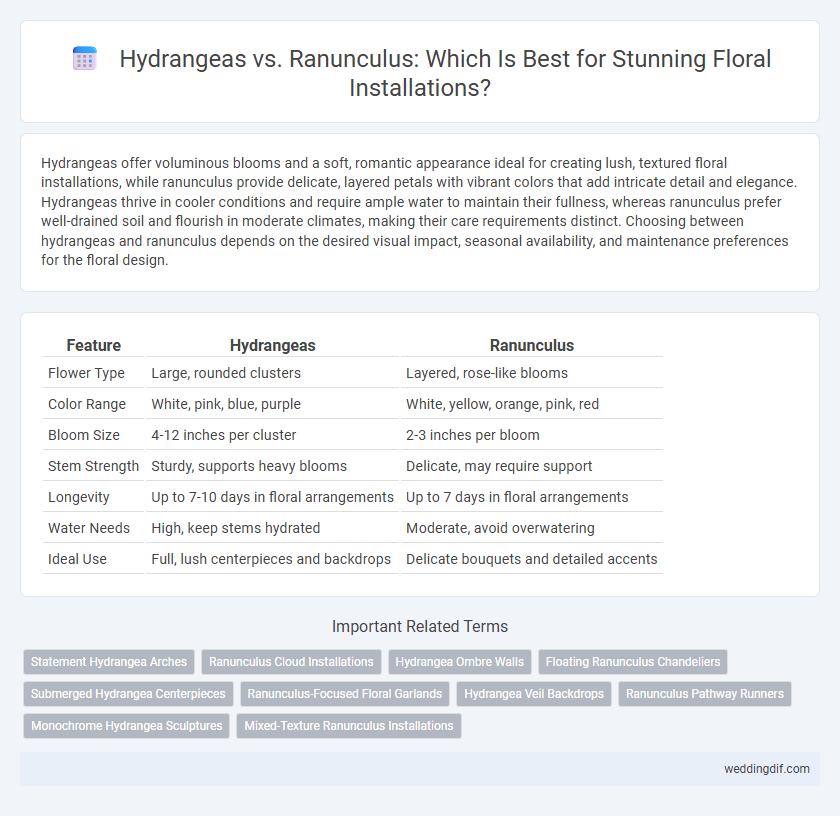Hydrangeas offer voluminous blooms and a soft, romantic appearance ideal for creating lush, textured floral installations, while ranunculus provide delicate, layered petals with vibrant colors that add intricate detail and elegance. Hydrangeas thrive in cooler conditions and require ample water to maintain their fullness, whereas ranunculus prefer well-drained soil and flourish in moderate climates, making their care requirements distinct. Choosing between hydrangeas and ranunculus depends on the desired visual impact, seasonal availability, and maintenance preferences for the floral design.
Table of Comparison
| Feature | Hydrangeas | Ranunculus |
|---|---|---|
| Flower Type | Large, rounded clusters | Layered, rose-like blooms |
| Color Range | White, pink, blue, purple | White, yellow, orange, pink, red |
| Bloom Size | 4-12 inches per cluster | 2-3 inches per bloom |
| Stem Strength | Sturdy, supports heavy blooms | Delicate, may require support |
| Longevity | Up to 7-10 days in floral arrangements | Up to 7 days in floral arrangements |
| Water Needs | High, keep stems hydrated | Moderate, avoid overwatering |
| Ideal Use | Full, lush centerpieces and backdrops | Delicate bouquets and detailed accents |
Hydrangeas vs Ranunculus: Key Differences for Wedding Florals
Hydrangeas offer voluminous blooms with a soft, romantic appearance and a color palette ranging from pastels to vibrant hues, making them ideal for creating lush, textured wedding installations. Ranunculus flowers feature densely layered petals and are prized for their delicate, rose-like look and wide spectrum of colors, adding intricate detail and elegance to floral arrangements. While hydrangeas provide bulk and a classic garden feel, ranunculus contribute refinement and visual interest, making both popular choices depending on the desired wedding floral style.
Color Variety: Hydrangeas and Ranunculus Compared
Hydrangeas offer a broad spectrum of colors including blue, pink, white, and purple, with hues often influenced by soil pH, making them ideal for customizing floral installations. Ranunculus displays vibrant shades ranging from soft pastels like cream and blush to intense reds, oranges, and yellows, providing dynamic color options for diverse designs. Both flowers deliver rich color variety, but Hydrangeas excel in volume and texture, while Ranunculus bring delicate layers and intricate petal structure to arrangements.
Texture and Shape: Visual Impact in Floral Installations
Hydrangeas offer large, rounded clusters with a soft, voluminous texture that create bold, eye-catching focal points in floral installations. Ranunculus features tightly layered, delicate petals forming intricate, rose-like shapes that add refined detail and dimensional contrast. Combining hydrangeas' lush, spherical blooms with ranunculus' sculptural elegance enhances the visual impact through texture and shape diversity.
Seasonal Availability: Hydrangeas vs Ranunculus
Hydrangeas bloom primarily in summer and early fall, offering a lush, voluminous texture ideal for large floral installations during these warmer months. Ranunculus, prized for their delicate, rose-like appearance, peak in spring and early summer, providing vibrant colors perfect for fresh, seasonal arrangements. Understanding the distinct seasonal availability of hydrangeas and ranunculus ensures optimal selection for lasting, visually striking floral designs.
Longevity and Freshness for Wedding Displays
Hydrangeas offer lush fullness but tend to wilt within 3 to 5 days, requiring careful hydration to maintain freshness for wedding displays. Ranunculus blossoms, with their delicate layered petals, typically last 7 to 10 days, providing longer-lasting vibrancy in floral installations. Choosing ranunculus ensures sustained longevity and freshness, making them ideal for extended wedding events.
Cost Comparison: Hydrangeas vs Ranunculus
Hydrangeas generally offer a more cost-effective option for large floral installations due to their affordability and availability in bulk, averaging around $3 to $5 per stem. Ranunculus, priced higher at approximately $6 to $10 per stem, tend to increase overall budget costs, especially in extensive arrangements. Selecting hydrangeas can reduce expenses without compromising visual volume, while ranunculus bring premium appeal and delicate texture at a higher investment.
Versatility in Design: Arrangement Ideas
Hydrangeas offer voluminous blooms and a soft, textured look perfect for lush, garden-style installations, while ranunculus provide delicate layers and vibrant colors ideal for intricate, romantic arrangements. Combining hydrangeas with ranunculus enhances depth and visual interest, allowing designers to create dynamic centerpieces, bouquets, and event decor with varied shapes and sizes. Both flowers adapt well to different design themes, from rustic to modern, making them versatile choices for creative floral installations.
Popular Wedding Themes for Each Flower
Hydrangeas are favored in rustic and garden-themed weddings for their voluminous blooms and soft pastel hues, creating a romantic and natural ambiance. Ranunculus are popular in modern and bohemian wedding themes, offering vibrant colors and delicate, layered petals that add elegance and texture. Both flowers complement floral installations but cater to different stylistic preferences, with hydrangeas emphasizing lush fullness and ranunculus highlighting intricate detail.
Care and Maintenance During Events
Hydrangeas require consistent hydration and cool temperatures to prevent wilting during events, making them sensitive to heat and drafts. Ranunculus flowers exhibit greater durability and longer vase life, tolerating warmer conditions with minimal water needs. Proper hydration techniques and environmental control are essential to maintain freshness in both flower types during floral installations.
Making the Final Choice: Hydrangeas or Ranunculus?
Hydrangeas offer voluminous clusters and a wide color range, making them ideal for creating lush, eye-catching floral installations with long-lasting freshness. Ranunculus provides delicate, multi-petaled blooms in vibrant hues, perfect for detailed, elegant arrangements requiring texture and fine detail. Choose hydrangeas for bold, substantial impact and ranunculus for intricate, refined designs that emphasize sophistication.
Hydrangeas vs Ranunculus for floral installations Infographic

 weddingdif.com
weddingdif.com